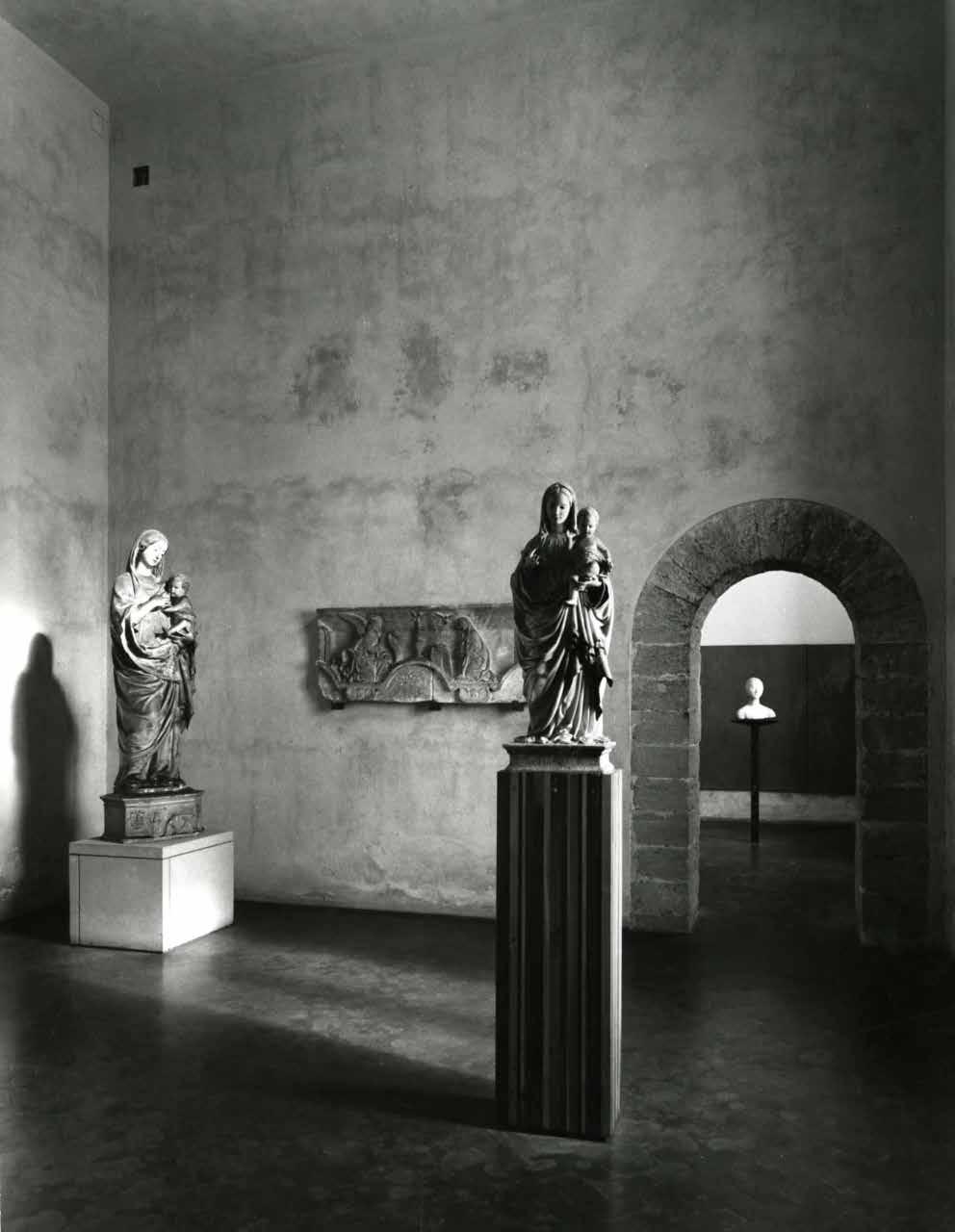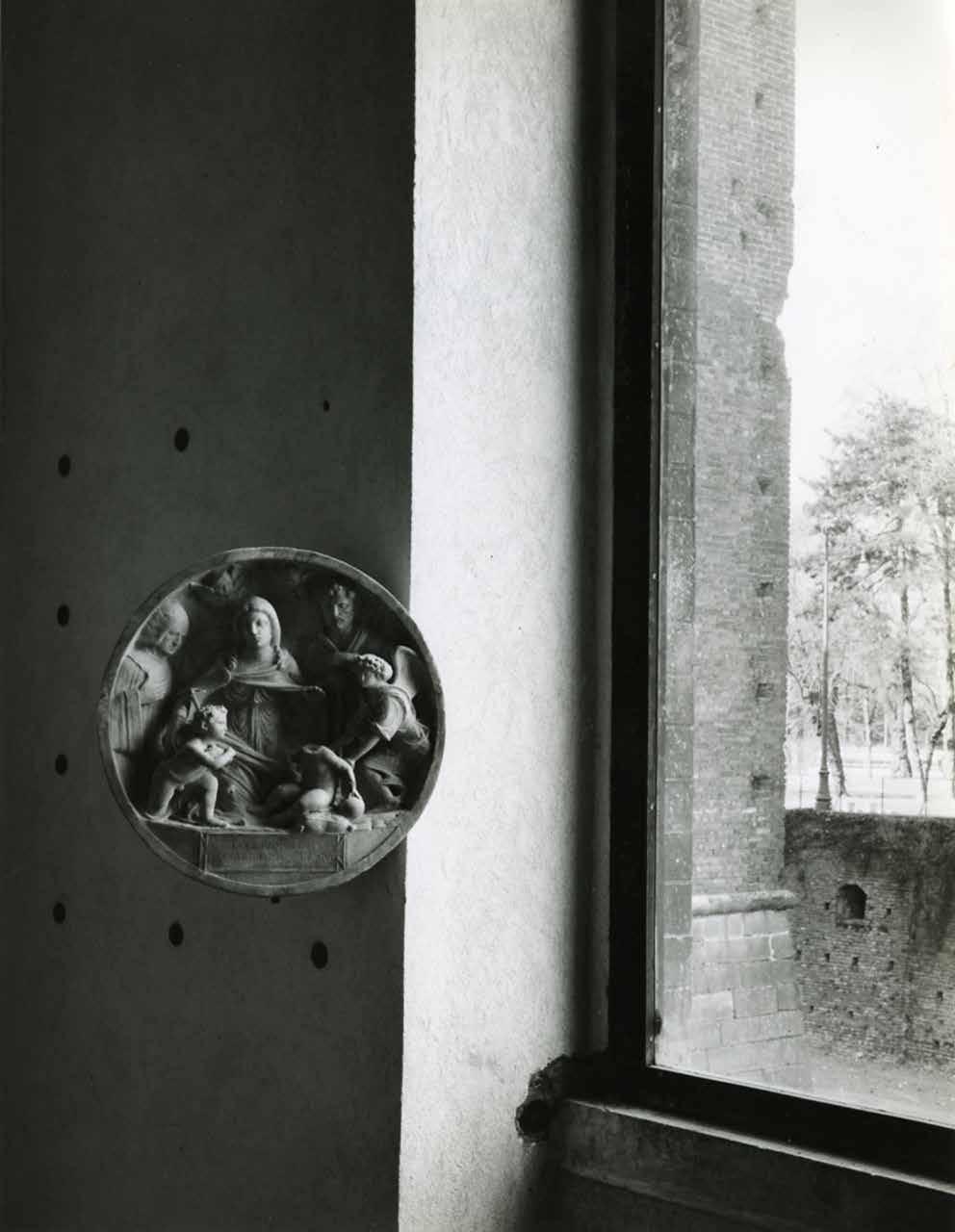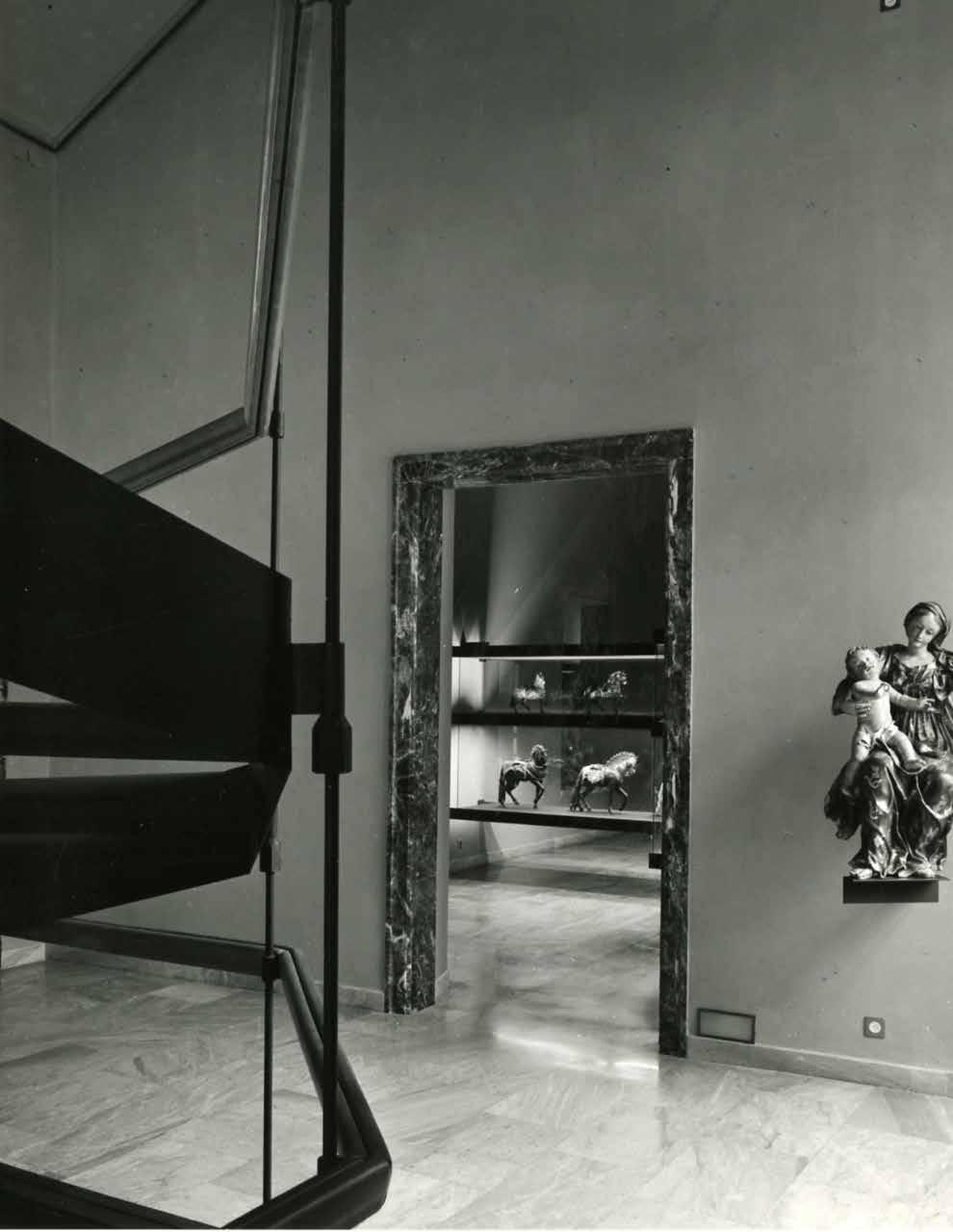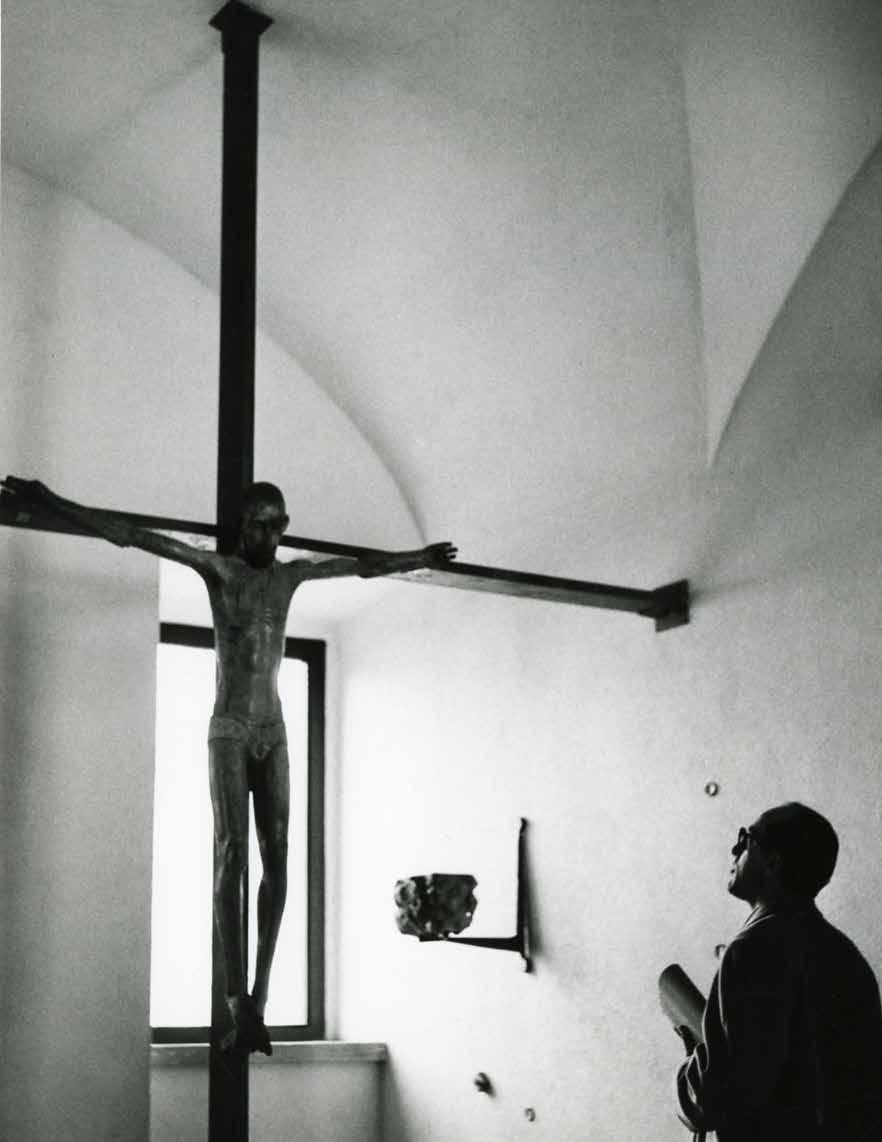
16 minute read
The Seismic Safety of Art Work
Marco Tanganelli DIDA | Department of Architecture, University of Florence
Fig. B FEM (FiniteElement Method) applied on the 3D model of Donatello’s Marzocco: static analysis for vertical loads
In the last years, a special attention has been paid to the conservation of cultural heritage. Due to both natural and anthropic hazards, many damages have occurred to the art works. New codes and guidelines have been dedicated to monumental and artistic goods, introducing proper procedures for their analysis and providing the needed thresholds for their safety assessment. With the increase of attention paid to the vulnerability of the cultural heritage, the analytical procedures able to provide the structural response of artistic goods subject to various loading conditions have been largely developed. The assessment of a safety level requires comparing the response of the investigated item under the assumed loading condition with the corresponding safety requirement. Besides the Technical Codes’ adequacy, the reliability of the safety assessment of artworks depends • on the quality of the performed analysis, • on the experimental knowledge at the basis of the modeling assumptions, • on the technology used for the diagnostic of the items. The best results in terms of safety assessment have been achieved by combining diagnostic, experimental campaigns, and modeling. Such a comprehensive approach provides a so-called knowledge path, which takes advantage of many different fields. It collects the available information on the artworks, including the changes, the moving, and the interventions determining their creation. The experimental survey made on material samples or entire items is fundamental to obtain the correct values to assume for performing the numerical analyses. The numerical procedures are the most general and effective approach for the seismic assessment of the artworks. They can be applied
to items with different features and seismic responses. They are quick, without requiring specific investment. In these last years, the Finite Element Method (FEM) has been widely developed due to the improvement of the geometrical survey and the introduction of the laser-scanner technology (Wittich et al. 2016, Bagnéris et al. 2017, Verdiani et al. 2019). Such technology leads to acquiring detailed geometrical models, which can be easily arranged and used for structural purposes. Moreover, the FE methods are very versatile. They can be differently set in order to account for specific properties of the represented system, such as the geometrical and mechanical non-linearity, or the possible sliding/rocking mechanism related to the description of the interface between the object and its support. This analytical approach has been widely used. It has been applied to Michelangelo’s David (Borri and Grazini 2006), whose safety has been checked referring to dynamic excitations, seismic and not. Many other studies regarding statues made in the Renaissance or the Roman ages and archeological ruins have been made (Berto et al. 2012, Viti et al. 2020). The FE methods can easily represent systems’ behavior, despite their geometrical complexity and the type of loading they are subjected to. However, the reliability of FEM needs to be checked by comparing the obtained results with some more straightforward analytical approaches or – even better – with an experimental comparison. Indeed, the high complexity of FEM could provide misleading results if the model is not correctly set.
References Bagnéris M. et al. 2017, ‘A complete methodology for the mechanical diagnosis of statue provided by innovative uses of 3D model. Application to the imperial marble statue of Alba-la-Romaine (France)’. Journal of Cultural Heritage, 28:109-116. Berto L. et al. 2012, ‘Assessment of seismic vulnerability of art objects: The “Galleria dei Prigioni” sculptures at the Accademia Gallery in Florence’, J C H 13, 7–21. Borri A., Grazini A. 2006, ‘Diagnostic analysis of the lesions and stability of Michelangelo’s David’, Journal of Cultural Heritage 7(4):273-285. Verdiani G., Tanganelli M., Paolucci R. 2019, ‘Great Statues and Seismic Vulnerability – A Photogrammetric Approach for Early Safeguard’. In: 23rd International Conference on Cultural Heritage and New Technologies 2018, Vienna, 4-6/11/2018, Museen der Stadt Wien – Stadtarchäologie, pp. 1-14. Viti S., Pintucchi B., Rotunno T., Tanganelli M. 2020, ‘The seismic analysis of Cerere at the Museum of Bargello’. Bulletin of Earthquake Engineering, 18(6), pp. 2635-2656, doi: 10.1007/s10518020-00802-6. Wittich C.E. et al. 2016, ‘Characterization of Full-Scale, Human-Form, Culturally Important Statues: Case Study’, Journal of Computational Civic Engineering., 30(3).
B) The Design Phase
General Remarks Given the information acquired with the forms, the second phase consists of improving an existing exhibition setup or designing a new museum setting. We try to address the questions linked to the museum setups through the design project: can museum displays be safe and coherent, according to updated exhibiting criteria? Can museography integrate with seismic prevention and museum policies? How? We can answer these questions through the exhibition design, holding together: consistent curatorial program, anti-seismic devices, and a coherent museographical project. We started from the principle of displaying. The act of showing is simple only in appearance and has to be cautiously solved. As Newhouse (2015) stated, it is a powerful gesture. A display project is or should be made by pondered decisions. After all, the art of displaying starts before the birth of museums. Over the centuries, the arrangement of statues and paintings in a space has changed according to different tastes, religious and symbolic meanings, political messages, and social contexts. Before the birth of museums, the objects’ position (we do not speak of works of art yet) followed political or personal basis. We can think about the path to the Acropolis with the position of statues and the sacred architectures (Le Corbusier 2008),21 the debate about the arrangement of Michelangelo’s David into the Signoria square (Wittkower 1998), and the interior layout of the Renaissance Studioli, like the one of Francesco I de’ Medici in Florence. With the establishment and opening of public museums, the staging of the spaces has started to follow different principles. The displays follow curatorial directions, determining objects’ grouping, order, and spatial distribution. Positioning an artifact in the space requires a careful study, ranging from architecture to environmental psychology, from ergonomic solutions to museum anthropology, from curatorship to communication. A non-recent document, edited by the French Ministry of Culture in 1986 (AA.VV. 1990), suggests some helpful exhibit guidelines for museums. It expresses a few basic but still topical museographical principles, for example:
A wrong codification of the display could lead to serious dangers. One risk is the standardization of museums in a rigid way and the trivialization of the museographical display. A mistaken approach would destroy one of the richest quality of museums, their uniqueness.
21 About the Acropolis, it is worth mentioning also the landscape work by Dimitris Pikionis (1954-57) (Ferlenga 2014).
The text enhances the importance of the object and its location:
In general, everything should start from the object, and everything should be put at the service of the object and its display. The exhibition general program has to be integrated with the evaluation of the “spatial potential” of each piece and its presence in the general scenography.22
To these passages, we add the importance of the specificity of the site (Pirazzoli 2013, 2011), the link between object and place, the respect for diversity, the necessity of previous studies involving the comparison of the possible design solutions and study of the references, and the necessity of a scientific program and prior detailed study of the site and the collections. Multidisciplinary teamwork has to take into consideration several variables. Moreover, introducing just anti-seismic devices to a museum setup, whether permanent or temporary, is not enough. Our goal is to consider the whole collection hosted in one room instead of the single object or a specific exhibition device and hold together all the aspects of an exhibition design.
Methodology Among the disciplines that equally contribute to foster the museum safety and preventive measures there is museography, or museum practice. That can be defined as the art of displaying,23 following the design and the organization of the spaces. Although sector-based,24 museography is characterized by a cross-sectorial approach and by the research of a constant dialogue with other disciplines, in and out the academia (Collotti 2017, Basso Peressut 2005). Museum practice determines the organization and the layout of a setting, allowing the presentation and the preservation of the contents. It is part of the Interior Architecture field and, as Museum Studies, is not considered an exact discipline. Interiors and museography are not based on scientific research, nor are purely artistic activities (Postiglione 2012). They do not fit a priori into a methodological framework. Instead, the research on museum design can be described as a mix of various approaches, based on observations, the study of the sources,25
22 Translated by the author from the Italian edition. The French original version Faire un musée. Comment conduire une opération muséographique? has been presented in 1986 and edited by La Documentartion Français. 23 Mairesse and Desvalées (2010) offer three more definitions. The first says: “Currently museography is essentially defined as the practical or applied aspect of museology, that is to say, the techniques which have been developed to fulfill museum operations, in particular about the planning and to fit out of the museum premises, conservation, restoration, security, and exhibition. In contrast to museology, the word museography has long been used to identify museums’ practical activities. The term is regularly used in the French-speaking world but rarely in the Englishspeaking one, where museum practice is preferred.” pp. 52-53 24 Museography is part of the Interior Architecture discipline. 25 Postiglione (2012) highlights the matter of the sources in the Interiors. He stresses the necessity of knowing the sources, divided into primary (original documents, interview, and the possibility of working directly with the object) and secondary (documents, essays, pictures, relief, re-drawings). The study of the references, the sketching, the maquette, the digital modeling, and the objects’ survey are all instruments used for our research.
Fig. 6 Gallery of the Palazzo Abatellis, Palermo. View of the exhibition rooms designed Carlo Scarpa and portrayed by Paolo Monti in 1961. Fig. 7 Gallery of Palazzo Bianco, Genoa. Franco Albini’s exhibit design photographed by Paolo Monti in 1963. Fig. 8 Castello Sforzesco, Milan. Detail of the setting developed by BBPR, picture by Paolo Monti in 1963. Fig. 9 Castello Sforzesco, Milan. Detail of the setup of the first floor of the Art Gallery designed by BBPR shot by Paolo Monti in 1956. design practice (composition), prototyping, and, eventually, realization and observation of the results in a given time. Lupo and Trocchianesi (2012) identify some methodologies: the scientific method used to observe and understand “how things are” (De Groot 1972; Popper 1959); the “building knowledge by design,” theorized by Richard Foqué (2010) as an experimental method playing with the models and practice, and by Sevaldson (2010) as explorative research; the “research through design,” according to the point of view by Archer (1995) and Frayling (1993), seen as a method “where the practice serves as research purpose” (Rust et al. 2007). The design process is a knowledge procedure.26 The several passages, from the study of the sources (comprehending archive and book research, the visit of the site) and of the references (analysis of coherent case studies) to the investigation of the subject, from the study of possible alternatives (composition, materials, technology) to the development of a prototype or standard layout, lead to the concretization of a formula that is not a design per se but is a solution proposing an answer to a given problem. The results are then published and promoted inside the scientific community. The design is the fruit of a multidisciplinary approach and the active collaboration among the several professions and actors included in the process. Therefore, the design results from a dynamic dialogue among different actors leading to various disciplines.
The Design Phase articulation The Design Phase is conducted only by experts and articulates in two steps: a-museographical analysis and b-set design. a) The museographical analysis comprises the study of the references. It is necessary to develop a coherent and accurate museum plan that integrates with the curatorial project, the technological anti-seismic suggestions, and all the required safety elements. The choice and study of the references relate to the site, the kind of collection, the curatorial program, and connect to the museum’s requests and needs. The study of museum spaces and their setups, the references, is a fundamental aspect of both research and practice in museum design. It can be conducted by studying books and texts, redrawing examples, and visiting cultural sites. In learning from the past and looking up to the future, we have to check for some remarkable case studies, providing
26 “Research by design is essentially practice-based and is the key to the development of a theory that can be applied in a practical situation. This theory is essentially pragmatic, necessarily dynamic and relative to the practice situation” (Foqué 2010, 153). Further, a practice-based theory “is typically not about explanations and justification (knowing why), but rather about establishing facts (knowing what) and instructions for actions (knowing how)” (Grand 2008, 401).




critical analyses and drawings of selected museum references, and studying anti-seismic museum solutions. Such a study helps identify the available range of solutions and understands others’ work (Collotti 1994). The study can be pursued at several levels, from general composition to a technological and digital solution, from graphics to space management. The investigation helps to identify the available range of solutions. As said, redrawing existing subjects is a way to understand architecture. The act of sketching is a crucial element in this phase. By tradition, it is an instrument of both research and design (Collotti 2014). The in situ fast representations of the spaces and settings help freeze concepts, understand the spaces’ articulation, and analyze volumes. The transfer of the signs on paper forces a specific kind of reasoning, different from taking pictures. The drawings might synthesize and illustrate some morphological aspects that a text or a chart might not efficiently communicate (Cerri 2018). Learning upon the references has a dual scope: learning from others’ experiences and ideas, and understanding if prominent examples satisfy the current safety levels. References need to be also contextualized. From a museum design point of view, we have to consider the Italian masters, like Albini, Scarpa, Michelucci, BBPR, and Castiglioni. They contributed to developing an essential cultural operation. They confronted themselves with historical architectures and the requests of the setting of invaluable collections. As a solution, they used the museum exhibition as an experimental field. These are valuable examples from which we can learn, with all due differences. Today, modest budgets and tight deadlines bound the space for experimentations, limiting the involvement of highly skilled artisans. b) As the name suggests, the set design step is the actual designing part. It considers previous analysis (phase1), the study of the references, the museum requests and needs, and develops together with other disciplines and professionals. The projects have to include new variables, such as audience development analysis, marketing strategies, mass tourism, blockbuster exhibitions, a new modality of visit, use of multimedia and technology, and the presence of other communication platforms. At the same time, the design has to respect or follows museum regulations and safety standards. Given the lack of anti-seismic measures, the design becomes a way to test safety solutions and hypothesize best practices and guidelines. Such a process of hypothesis and testings is comprehended in the “research by design” methodology. The outcomes describe a path of findings that might be presented in publications and scientific conferences.
Seismic Safety of Objects on Display: Regulations, Guidelines, and Protocols The Design Phase must consider guidelines, standards, and shared protocols to protect museums and museum collections from various risks delineated by International committees, museums, and cultural institutions. Museum Security and Protection, A handbook for cultural heritage institutions, by ICOM and ICMS (1993), is a general textbook with international standards and necessary security procedures. Later, other texts have been released. We already mentioned Running a Museum: A Practical Handbook (2005) by ICOM: a compact manual born to be a reference book to those working in Iraqui museums. Given the universal interest of the topic, this has been customized to be an introductory book dedicated to all the people working in museums. Other texts came along (Jalla 2015), sharing the necessity of setting standard basic parameters and procedures to protect, preserve, and enhance cultural goods. Like the Smithsonian Museums, Canadian museums, and the Metropolitan Museum of New York, some prominent museums set up a series of guidelines and regulations about conserving and protecting their collections. In Italy, the text elaborated jointly by MIBACT, ICOM, and Carabinieri Art Squad (Carabinieri Nucleo Tutela Patrimonio Culturale) (2015) updated a document in the field of protection. Though dedicated to the protection against theft, vandalism, terrorism, and smuggler, it proposes practical measures and suggestions on the risk assessment of the museum settings.27 Preventive and protecting measures concern both temporary and permanent setups. In organizing temporary exhibitions, both lender and hosting institution have to follow some procedures and restrictive protocols regulated by the London Agreement (IEO 2002) and following revisions (IEO 2009). Among the several documents,28the Facility Report is one of the most important. It consists of a form describing the hosting institution’s venue. The loaning institutions will give their clearance to proceed only after verifying that the spaces of the hosting museum satisfies the mandatory conditions. The Facility Report lists all the existing safety measures, but the anti-seismic devices are not required as they have not yet been coded. This document lists the requested safety and conservation measures, like alarming cases, hygrometric environment, and light temperature. The documents are precious and necessary, but none of them specify ad hoc normative about the seismic hazard. Other documents are dedicated to the single objects, as the Loan Form (and or a Loan Agreement). An ID identifies
27 The Carabinieri Command for the Protection of Cultural Heritage, Carabinieri TPC, is in charge of the crimes against art and antiquities. General Ferrara founded it in 1969. It was the first special police force in the world of this kind, anticipating the UNESCO convention on the Means of Prohibiting and Preventing the Illicit Import, Export and Transfer of Ownership of Cultural Property (1970). 28 The essential documents are: the scientific program of the exhibition, the Loan Form and/or Loan Agreement, the Facility Report of the hosting structure. As the name law declares, in Italy, the DM 330 30/06/2016 establishes “the criterion to open to the public, the surveillance, and the safety of museum and cultural sites.”
every object and a correspondent form collects all the information related to each traveling piece. The loan must be validated by a double agreement between the two institutions by stipulating an insurance policy on loans. Although ICOM and UNESCO’s documents are mainly devoted to emergencies and the recovery after a natural disaster (Sendai 2015; ICOMOS 2014; HFA 2013, 2007), they do not contain advice about prevention against earthquakes. By now, common sense, practice, and high expertise of the museum staff are the most effective preventive measures.
C) Installation Phase
The last step is the realization of the design and includes the executive plans. Analysis and speculations bring to this step, in which finally what has been envisioned can be realized. It is worth noticing that the application can be both heavy or light. Let us take the Getty example. Its staff approached the seismic safety of the collections in two ways: by applying non-invasive solutions without modifying the general asset of the exhibition (light intervention) and by reorganizing the interior articulation of the rooms (heavy intervention). There are substantial differences between the two outcomes: costs, general complexity, and actors involved. Still, both solutions work according to a general museographic plan and increase safety level of the museum. Once at this stage, the project should be documented and shared, so to foster the construction of best practices and guidelines, and becoming potential references to other’s work.










